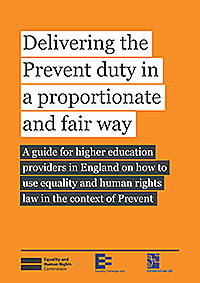S 43 Education (No. 2) Act 1986 (Freedom of speech in universities, polytechnics and colleges) requires “Every individual and body of persons concerned in the government” of further and higher education institutions to “take such steps as are reasonably practicable to ensure that freedom of speech within the law is secured” for staff, students and visiting speakers. The institutions must ensure, “so far as is reasonably practicable”, that use of the premises is not denied to anyone on any ground connected with their beliefs, views, policy or objectives. On the other hand, the Prevent duty in s 26 Counter-Terrorism and Security Act 2015 requires specified authorities – including relevant higher education bodies – to have due regard in the exercise of their functions to the need to prevent people from being drawn into terrorism.
This is a complex and difficult area; and the Equality and Human Rights Commission has produced a guide for higher education providers in England on equality and human rights law in the context of the Prevent strategy.
 As well as a duty under the Prevent strategy to put systems in place to identify, challenge and address extremism in order to help prevent vulnerable staff and students from being drawn into terrorism, most higher education providers will also have responsibilities under equality and human rights law. The guide is intended for governors with responsibility for ensuring that their institution complies with all its obligations under the law and for Prevent leads with responsibility for identifying risks relevant to the Prevent duty and developing an action plan to mitigate those risks.
As well as a duty under the Prevent strategy to put systems in place to identify, challenge and address extremism in order to help prevent vulnerable staff and students from being drawn into terrorism, most higher education providers will also have responsibilities under equality and human rights law. The guide is intended for governors with responsibility for ensuring that their institution complies with all its obligations under the law and for Prevent leads with responsibility for identifying risks relevant to the Prevent duty and developing an action plan to mitigate those risks.
In practice, the EHRC expects governors of HE institutions:
- to promote the requirements under the Equality Act 2010 and the Human Rights Act 1998 as useful tools to ensure compliance with the Prevent duty in a proportionate and fair way;
- to ensure that staff receive training on the Prevent duty that covers relevant and applicable equality and human rights obligations, raises awareness of different cultural and religious practices and beliefs, and addresses the bases of prejudices and stereotyping;
- to ensure that their institution’s Prevent lead conducts a thorough assessment of the impact of the proposed action plan on equality, human rights and good relations and has made every effort to consult with interested parties in the process;
- to consider such an assessment before making a decision on whether an action should be implemented;
- to check that actions taken to comply with the Prevent duty are adequately monitored for their actual impact on equality, human rights and good relations; and
- to make sure that complaints by staff and students about actions taken under the Prevent duty are dealt with in a timely and effective manner, that lessons are learned across the institution and that the Prevent action plan is amended where appropriate.
The issue was the subject of a consultation at St George’s, Windsor, late in 2016 and the report of the consultation, Freedom of Speech in Universities, has just been published. The areas of disagreement between participants revealed by the report are particularly interesting and worth quoting in full:
- Some participants felt strongly that there is a “crisis” of freedom of speech. Others agreed that there is a “chilling effect” on free expression but felt that more research is needed before the term “crisis” can justifiably be used.
- Some participants argued that both the Prevent duty and student actions like no platforming and safe space policies are constraining freedom of speech on campus. Meanwhile, others placed prime emphasis on either the Prevent duty or the student policies as the main source of the problem. There was also disagreement about whether the problem with the policies was the policies themselves, or implementation or design.
- Since there was disagreement on the extent to which the Prevent duty or student policies constrain freedom of speech, there was also division on the proposed solutions. In broad terms, there were three possible approaches to the policies (both the Prevent duty and the student policies):
- The problem is in the policy’s implementation; better training is needed for those people carrying it out.
- The problem is in the policy’s design; the policy needs to be reformed.
- The problem is the policy itself; the policy needs to be dropped. Either:
- The policy needs to be replaced; or:
- The pre-existing duty of care mechanisms are sufficient for keeping campuses and students safe.
- Some participants emphasised the harm that can be done by speech which is lawful but which intimidates or is offensive to particular groups of students. In this view, restricting such speech and creating safe spaces will enable all students to flourish and to express their own views freely. On the other hand, other participants were concerned that safe space policies can protect particular ideas from critical challenge and can reduce students’ exposure to a wide range of views. In the balance between freedom of speech and freedom from harm, they placed especial emphasis on the former.
